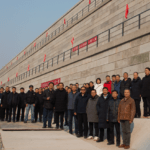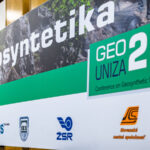 The primary objective of building the multimillion dollar Kazungula Bridge was to link Zambia, Zimbabwe and Botswana in order to ease tourist traffic and enhance trade and integration between these three African countries. Once completed, the bridge, which spans the Zambezi River at the intersection of the Chobe River, will replace the existing ferry linking Botswana and Zambia. When an erosion concern was raised during the project, CCP consulting engineers approached Kaytech to submit a design solution that was both financially plausible and technically sound.
The primary objective of building the multimillion dollar Kazungula Bridge was to link Zambia, Zimbabwe and Botswana in order to ease tourist traffic and enhance trade and integration between these three African countries. Once completed, the bridge, which spans the Zambezi River at the intersection of the Chobe River, will replace the existing ferry linking Botswana and Zambia. When an erosion concern was raised during the project, CCP consulting engineers approached Kaytech to submit a design solution that was both financially plausible and technically sound.
Danie Herbst, Technical Sales Representative explains the problem: “Because the approach to the bridge is built up in layers of Kalahari sand, there was an issue regarding the slopes that might be affected by erosion. Another problem was that game, especially elephants applying heavy loads, when migrating from the plains to the upper swampy areas, could cause serious soil erosion when crossing the layers of Kalahari sand used to construct the approach to the bridge. We took this all into account when finding a solution to the erosion control method needed.”
After careful consideration, Herbst decided a combination of Strataweb 330-75 geocell, and Enviromat, a biodegradable erosion control blanket would create more than adequate reinforcement for the vulnerable slopes. Manufactured from HDPE, Strataweb is a lightweight, but strong, three-dimensional honeycomb-shaped cellular confinement system used as a foundation mat that improves load bearing capacities of weak soils and acts as an erosion control barrier for slope surfaces. Depending on site requirements, the geocell system can be infilled with gravel, concrete or, as in this project, topsoil. By confining and reinforcing vegetation on steep slopes, the soil’s natural resistance to erosion is increased and the root zone layer is protected during germination.
The biodegradable Enviromat, consisting of woodwool extracted from the alien Poplar tree and contained within an external polypropylene mesh, is used to combat soil erosion on exposed slopes. Vegetative growth is stimulated while topsoil and germinating seeds are protected from the elements. No adhesives or chemicals are used in the manufacture of this product. As per the supplied design, contractor Zhong Gan Engineering and Construction installed 16 000 m2 of the geocell system directly onto the seeded slopes followed by a similar size layer of the erosion control blanket.
The geocell system will effectively transfer compressive and tensile stresses from heavy animal traffic thus providing the embankment slopes with a significant load bearing capacity. Meanwhile, due to UV exposure and the prevailing climatic conditions, the protective layer of the erosion control blanket will gradually degrade over a period of 12 -36 months, leaving behind well-established vegetated slopes. Importantly for this project taking place outside South Africa, this is a sterile product that does not import unpredictable organic materials or unwanted seeds onto site.
Due for completion by 2020, the Kazungula Bridge will open one of the busiest corridors in the Southern African Development Community (SADC) region helping to link landlocked countries to the export/import hub in the port of Durban.
By combining these two specialist erosion control products, a unique solution was provided for an environmental problem; preventing the natural migration of grazing animals from causing serious soil erosion, and possible damage to the approach embankments of the newly built Kazungula Bridge.
For more information on Kaytech products and systems, visit www.kaytech.co.za






















